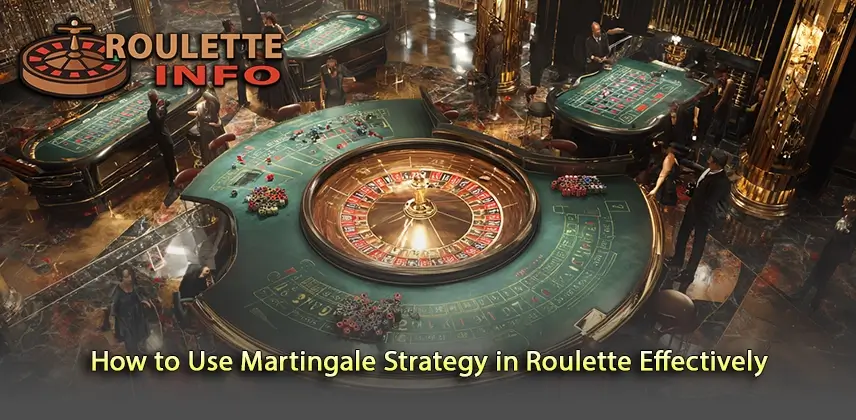The Martingale Strategy in Roulette is a classic betting method that has fascinated gamblers for generations. This strategy involves doubling your bet after every loss in hopes of recovering all previous losses plus gaining a small profit when you eventually win. If you’re looking to understand how to implement the Martingale Strategy in live roulette effectively, explore real examples, compare it with other strategies, and receive professional advice, this comprehensive guide will illuminate every aspect.
Understanding the Martingale Strategy in Roulette Basics
Before diving into how to use the Martingale Strategy in Roulette, it’s vital to grasp the fundamental mechanics of both the game and the strategy itself. Roulette offers various betting options, but Martingale focuses primarily on even-money bets that have close to a 50% chance of winning (like red/black or odd/even). The strategy’s premise is straightforward but requires careful attention to bankroll and table limits.
How the Martingale System Works in Roulette
The Martingale Strategy hinges on a simple principle: after each loss, you double your bet. This means that when a winning spin finally occurs, it recoups all previous losses plus the original bet’s winnings. For example, if your first bet is $10 and you lose, your next bet becomes $20. If that also loses, your next is $40, then $80, and so on, until you win.
The beauty of this system is its simplicity. It plays off the theory of probability that a losing streak will eventually end, and when it does, the player breaks even or makes a small profit. However, this simplistic approach masks deeper risks involving bankroll limits and table maximums.
Why Even-Money Bets Are Ideal for Martingale
The Martingale Strategy is designed around bets with almost a 50% chance of winning to capitalize on the near-even odds. Bets like red/black, odd/even, or high/low in Roulette offer close-to-even payout chances, making them the prime candidates for this strategy.
Using odds that offer a more than 50% chance of winning ensures fewer long losing streaks theoretically, while sticking to close-to-even bets allows doubling bets that maximize the chance to break even or profit. This selection reduces but does not eliminate risks inherent in progressive betting schemes.
The Role of Table Limits and Bankroll in Martingale
Despite its mathematical appeal, the Martingale Strategy can be curtailed by the casino’s table limits and the gambler’s bankroll. If a losing streak extends beyond the player’s bankroll or exceeds the maximum allowed bet on the table, the doubling system collapses, potentially incurring massive losses.
Thus, understanding and setting clear betting limits and bankroll management policies is essential when employing the Martingale Strategy in Roulette to avoid catastrophic financial consequences while trying to exploit the strategy’s edge.
>>> Fibonacci Strategy in Roulette
How to Use Martingale Strategy in Roulette Effectively

Implementing the Martingale Strategy in Roulette isn’t simply about doubling bets after losses. It requires a disciplined approach, clear rules, and an understanding of when to walk away. This section explores practical ways to use Martingale with examples and strategic insights.
Step-by-Step Guide to Using the Martingale Strategy
First, decide your initial bet — an amount you’re comfortable risking repeatedly. Place this bet on an even-money option such as red or black. If you win, pocket the profits and start again at the base bet.
If you lose, double the bet on the next spin and continue doubling after every loss until a win occurs. Once you win, you recover all previous losses and make a profit equal to your initial bet.
Example: A Martingale Betting Sequence
Imagine you start with an initial bet of $5 on red.
- Bet 1: $5 (loss)
- Bet 2: $10 (loss)
- Bet 3: $20 (loss)
- Bet 4: $40 (win)
At Bet 4, the winning $40 bet covers the prior $5 + $10 + $20 losses totaling $35 and makes a $5 profit, equal to your original bet. After winning, the player resets to $5 for the next round.
Such an example demonstrates the power of Martingale to recoup losses. But this also highlights the steep escalation in risk and capital requirements during losing streaks.
Important Tips When Using Martingale in Roulette
- Always set a loss limit to avoid depletion of your bankroll during an extended losing streak.
- Know your table’s maximum bet to avoid reaching a bet size that’s not allowed by the casino.
- Consider your session time: Martingale works best on short sessions due to compounding risk. By incorporating these practices, players can leverage the Martingale Strategy in Roulette more safely and controllably.
Comparing Martingale Strategy in Roulette to Other Betting Systems
There are many betting strategies, but Martingale is unique for its simplicity and risk profile. Comparing it to others helps highlight its strengths and weaknesses to decide its suitability for different types of players.
Martingale vs. Reverse Martingale
The Reverse Martingale (or Paroli) involves doubling bets after wins instead of losses. This approach aims to capitalize on winning streaks, in contrast to Martingale’s focus on recovering losses.
While Martingale exposes the gambler to escalating losses during losing streaks, Reverse Martingale risks profits accumulated and can cull losses faster. However, the profit potential in Reverse Martingale depends heavily on luck to maintain winning streaks, whereas Martingale guarantees small profits if not limited by bankroll or table limits.
Martingale vs. Fibonacci Strategy
The Fibonacci betting system bases bet sizes on the Fibonacci sequence (1, 1, 2, 3, 5, 8…), increasing bets more gradually after losses. This results in less aggressive capital requirements compared to Martingale’s doubling pattern.
Martingale offers quicker recovery but higher risk, while Fibonacci reduces risk at the expense of longer recovering periods and potential for smaller profits. Players with limited bankrolls may find Fibonacci safer but with slower gains.
When Is Martingale the Best Choice?
Martingale suits players who:
- Have a sufficiently large bankroll
- Prefer a straightforward, structured system
- Can tolerate large bet sizes temporarily during losing streaks
For casual or low-risk players, alternative strategies may be more fitting. Martingale balances risk and reward in an all-or-nothing style that appeals to those willing to accept high variance.
Professional Advice and Cautions for Using Martingale Strategy in Roulette
Expert gamblers and casino veterans offer crucial advice to maximize the benefits and minimize the pitfalls when using Martingale.
Bankroll Management Is Crucial
Never start Martingale without a bankroll that can sustain several losses in a row, which may escalate exponentially. Calculate your maximum potential loss before you begin and be ready to accept it.
Be Wary of Table Limits
Table maximum bet limits are designed to prevent strategies like Martingale from working indefinitely. If you hit the limit before recouping losses, the system fails, resulting in a large loss.
Always verify table limits before applying Martingale and consider starting with lower initial bets to extend your playing range within limits.
Know When to Quit
Martingale is seductive because of its promise to win small profits repeatedly. However, it’s wise to set win and loss limits for your session and walk away when you reach them. Chasing losses after a losing streak can be financially devastating.
Discipline, self-control, and realistic expectations are essential traits for anyone employing Martingale Strategy in Roulette.
Summary of Key Considerations:
- Choose small initial bets.
- Understand and respect table limits.
- Prepare for losing streaks with an adequate bankroll.
- Set stop-loss and stop-win goals.
- Never chase losses beyond your planned limits.
Following these can make the Martingale Strategy a manageable and potentially profitable tool in a player’s arsenal.
Conclusion
The Martingale Strategy in Roulette offers a simple yet powerful betting approach that can provide short-term wins by doubling bets after losses. However, it carries significant risks tied to losing streaks, bankroll constraints, and table limits. Understanding how to use the strategy effectively, comparing it to other systems, and adhering to professional advice on bankroll and limits are crucial steps for anyone considering Martingale. While no strategy guarantees success at the roulette table, informed use of the Martingale Strategy in Roulette can maximize your chances while managing risks intelligently.

